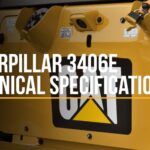The Caterpillar 3126E engine, a turbocharged 7.2L inline 6-cylinder diesel engine, was introduced in 1997 as Cat’s first electronic mid-range diesel engine. It succeeded the 3116, but both engines initially faced criticism due to issues like cracked blocks and dropped valves, often attributed to a faulty French foundry. However, Caterpillar proactively recalled the affected 3116 blocks. Further concerns arose from marine applications where engines were overstressed beyond their 2200 rpm redline, leading to premature failures. When operated within specifications, the 3126E proves to be a reliable workhorse.
Cat 3126E Engine Applications
The Cat 3126e Engine found its way into diverse sectors, showcasing its versatility and power:
- Construction: Powering heavy machinery like excavators and loaders.
- Agriculture: Driving tractors and other agricultural equipment.
- Marine: Propelling boats and ships.
- Buses: Providing reliable transportation.
- Ambulances: Ensuring timely emergency response.
Common Cat 3126E Engine Problems
While generally robust, the 3126E engine isn’t immune to problems. Recognizing these issues can lead to timely intervention and prevent catastrophic failures:
- Spun Crankshaft Bearings: Often caused by oil starvation or excessive wear.
- Cracked Cylinder Head(s): Resulting from overheating or excessive pressure.
- Scored Pistons and Liners: Due to poor lubrication or foreign object ingestion.
- Over Fueling: Leading to excessive soot and potential engine damage.
- Low Oil Pressure: Indicating a critical lubrication problem.
- Excessive Blow By: Signifying worn piston rings or cylinder walls.
- Dropped Valves: A serious issue potentially damaging pistons and cylinders.
- Camshaft Failure: Affecting valve timing and engine performance.
- Crankshaft Failure: A catastrophic event often requiring engine replacement.
- Lifter/Roller Failure: Leading to reduced engine performance and potential valve damage.
Cat 3126E Engine Replacement Options
When engine problems become severe, replacement might be the most viable solution. Factors like cost, downtime, and availability influence the decision-making process. While a new engine from a dealer offers peace of mind, remanufacturing provides a cost-effective alternative.
The Cat 3126E Remanufacturing Process
Remanufacturing involves a comprehensive rebuild of the engine to original equipment manufacturer (OEM) specifications. This process offers a sustainable and economical solution for extending the life of a Cat 3126E engine.
Key Steps in the Remanufacturing Process:
- Thorough Cleaning: Removing all contaminants to prevent future failures.
- Crankshaft Machining: Precision machining, polishing, and magnafluxing to ensure proper tolerances.
- Cylinder Head Resurfacing: Guaranteeing a proper sealing surface and compatibility with new gaskets.
- Cylinder Block Inspection and Machining: Addressing cracks, boring and honing cylinders, and ensuring proper surface finish.
- Camshaft Inspection and Machining: Verifying correct lift and meeting OEM tolerances.
- Connecting Rod Reconditioning: Cleaning, machining, and fitting new bushings to ensure proper stress distribution.
- New Parts Installation: Utilizing new pistons, rings, bearings, gaskets, seals, and liners (OEM or aftermarket when available) for optimal performance and reliability.
Conclusion
The Cat 3126E engine, despite early challenges, proved its worth in various demanding applications. Understanding its potential problems and exploring remanufacturing options can help owners maximize the engine’s lifespan and minimize downtime. By adhering to proper maintenance schedules and operating the engine within its designed parameters, owners can ensure the Cat 3126E delivers reliable power for years to come.

